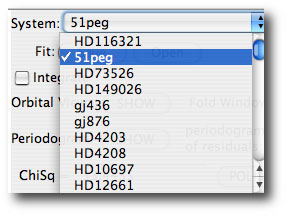Most of the recent scientific papers on the general topic of extrasolar planets start with a sentence very much like this one:
Following the announcement of the planet orbiting 51 Peg (Mayor & Queloz 1995), over 170 planets have been discovered in orbit around solar type stars.

And indeed, Mayor and Queloz’s discovery of the hot Jupiter orbiting 51 Peg was truly a watershed event. Their Nature paper has racked up 764 ADS citations. Of order several billion dollars have been spent (or will shortly be spent) on the worldwide effort to locate and characterize alien solar systems. It’s thus a little weird that the Systemic Console has so far failed to include 51 Peg in its system menu. We’ve just corrected this oversight by adding the two published data sets for 51 Peg.

The closely spaced data near the beginning of the time series is from Marcy et al. (1997), who began intensively monitoring the planet from Lick Observatory as soon as the discovery was announced. The widely spaced data is from the Swiss planet hunting team (Naef et al. 2004), and contains 153 radial velocities obtained over a ~10-year period. The data is catalogued at CDS, and available at this link.
The 51 Peg data sets are interesting for a number of reasons. I’ll check in tomorrow with more details as to why. In the meantime, fire up the console and start finding fits.

A quick p.s.: We’ve also just added another classic “old school” system, 70 Vir, to the console list. The data you’ll see on the console comes from the Swiss team’s repository on CDS. It’s very easy to recover the published planet from the 70 Vir data set, and it’s interesting to check out the possibilities for hiding additional (as-yet unannounced) planets in this system.
Pingback: systemic - 51 Peg c
Pingback: systemic - Some evidence for the existence of 51 Peg c